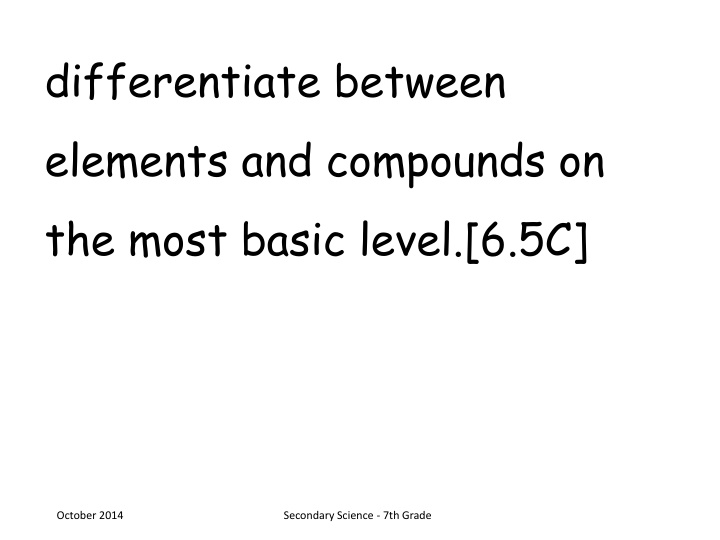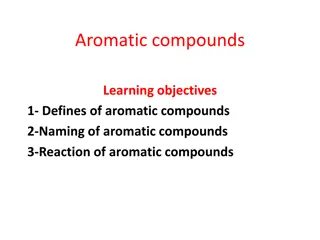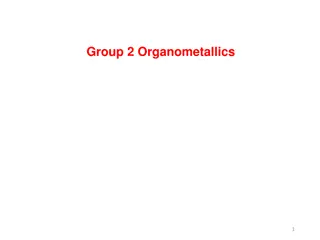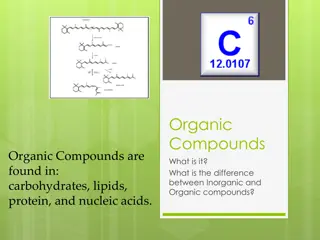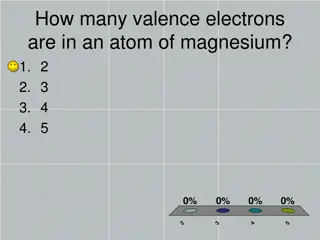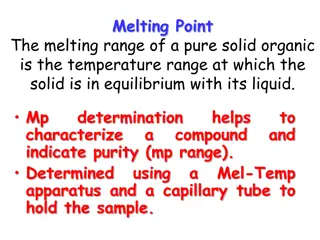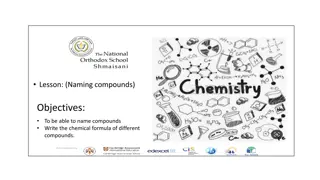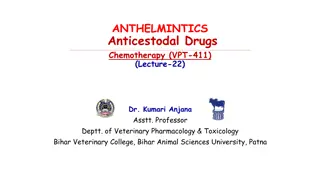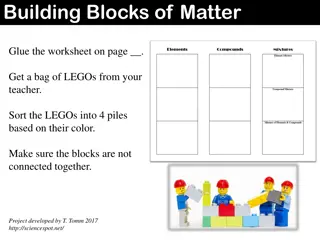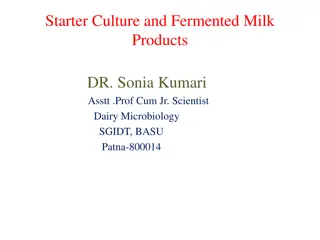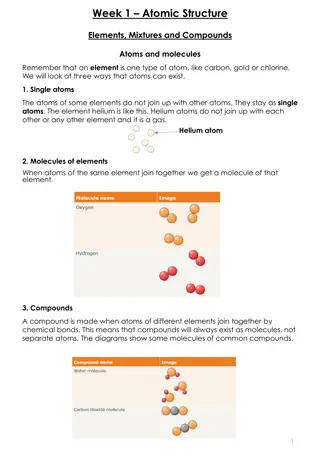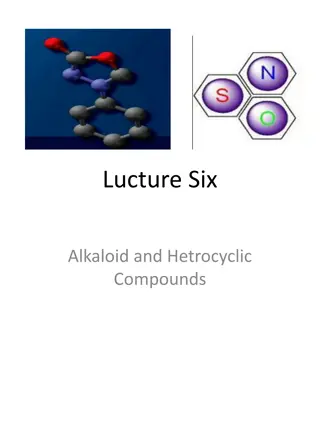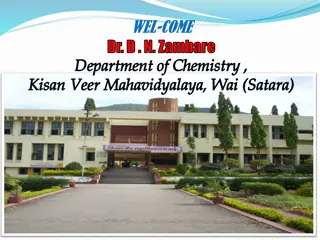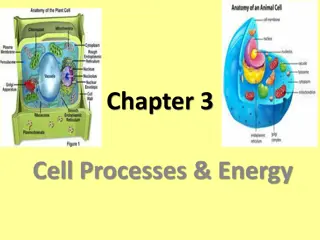Differentiating Elements and Compounds: Basics Explained
In science, understanding the difference between elements and compounds is crucial. Elements are pure substances made of only one type of atom, while compounds are made of different elements chemically combined. Explore this fundamental concept along with density calculations, energy transformations, organism characteristics, and more in this educational resource for 7th-grade science students.
Download Presentation

Please find below an Image/Link to download the presentation.
The content on the website is provided AS IS for your information and personal use only. It may not be sold, licensed, or shared on other websites without obtaining consent from the author.If you encounter any issues during the download, it is possible that the publisher has removed the file from their server.
You are allowed to download the files provided on this website for personal or commercial use, subject to the condition that they are used lawfully. All files are the property of their respective owners.
The content on the website is provided AS IS for your information and personal use only. It may not be sold, licensed, or shared on other websites without obtaining consent from the author.
E N D
Presentation Transcript
differentiate between elements and compounds on the most basic level.[6.5C] October 2014 Secondary Science - 7th Grade
calculate density to identify an unknown substance.[6.6B] October 2014 Secondary Science - 7th Grade
compare and contrast potential and kinetic energy. [6.8A] October 2014 Secondary Science - 7th Grade
calculate average speed using distance and time measurements. [6.8C] October 2014 Secondary Science - 7th Grade
measure and graph changes in motion.[6.8D] October 2014 Secondary Science - 7th Grade
demonstrate energy transformations such as energy in a flashlight battery changes from chemical energy to electrical energy to light energy.[6.9C] October 2014 Secondary Science - 7th Grade
identify the basic characteristics of organisms, including prokaryotic or eukaryotic, unicellular or multicellular, autotrophic or heterotrophic, and mode of reproduction, that further classify them in the currently recognized Kingdoms.[6.12D] October 2014 Secondary Science - 7th Grade
recognize that radiant energy from the Sun is transformed into chemical energy through the process of photosynthesis.[7.5A] October 2014 Secondary Science - 7th Grade
demonstrate and explain the cycling of matter within living systems such as in the decay of biomass in a compost bin.[7.5B] October 2014 Secondary Science - 7th Grade
diagram the flow of energy through living systems, including food chains, food webs, and energy pyramids.[7.5C] October 2014 Secondary Science - 7th Grade
identify that organic compounds contain carbon and other elements such as hydrogen, oxygen, phosphorus, nitrogen, or sulfur.[7.6A] October 2014 Secondary Science - 7th Grade
distinguish between physical and chemical changes in matter in the digestive system.[7.6B] October 2014 Secondary Science - 7th Grade
recognize how large molecules are broken down into smaller molecules such as carbohydrates can be broken down into sugars.[7.6C] October 2014 Secondary Science - 7th Grade
contrast situations where work is done with different amounts of force to situations where no work is done such as moving a box with a ramp and without a ramp, or standing still.[7.7A] October 2014 Secondary Science - 7th Grade
illustrate the transformation of energy within an organism such as the transfer from chemical energy to heat and thermal energy in digestion.[7.7B] October 2014 Secondary Science - 7th Grade
demonstrate and illustrate forces that affect motion in everyday life such as emergence of seedlings, turgor pressure, and geotropism.[7.7C] October 2014 Secondary Science - 7th Grade
predict and describe how different types of catastrophic events impact ecosystems such as floods, hurricanes, or tornadoes.[7.8A] October 2014 Secondary Science - 7th Grade
analyze the effects of weathering, erosion, and deposition on the environment in ecoregions of Texas.[7.8B] October 2014 Secondary Science - 7th Grade
model the effects of human activity on groundwater and surface water in a watershed.[7.8C] October 2014 Secondary Science - 7th Grade
analyze the characteristics of objects in our solar system that allow life to exist such as the proximity of the Sun, presence of water, and composition of the atmosphere.[7.9A] October 2014 Secondary Science - 7th Grade
identify the accommodations, considering the characteristics of our solar system, that enabled manned space exploration.[7.9B] October 2014 Secondary Science - 7th Grade
observe and describe how different environments, including microhabitats in schoolyards and biomes, support different varieties of organisms.[7.10A] October 2014 Secondary Science - 7th Grade
describe how biodiversity contributes to the sustainability of an ecosystem.[7.10B] October 2014 Secondary Science - 7th Grade
observe, record, and describe the role of ecological succession such as in a microhabitat of a garden with weeds.[7.10C] October 2014 Secondary Science - 7th Grade
examine organisms or their structures such as insects or leaves and use dichotomous keys for identification.[7.11A] October 2014 Secondary Science - 7th Grade
explain variation within a population or species by comparing external features, behaviors, or physiology of organisms that enhance their survival such as migration, hibernation, or storage of food in a bulb.[7.11B] October 2014 Secondary Science - 7th Grade
identify some changes in genetic traits that have occurred over several generations through natural selection and selective breeding such as the Galapagos Medium Ground Finch (Geospiza fortis) or domestic animals.[7.11C] October 2014 Secondary Science - 7th Grade
investigate and explain how internal structures of organisms have adaptations that allow specific functions such as gills in fish, hollow bones in birds, or xylem in plants.[7.12A] October 2014 Secondary Science - 7th Grade
identify the main functions of the systems of the human organism, including the circulatory, respiratory, skeletal, muscular, digestive, excretory, reproductive, integumentary, nervous, and endocrine systems.[7.12B] October 2014 Secondary Science - 7th Grade
recognize levels of organization in plants and animals, including cells, tissues, organs, organ systems, and organisms.[7.12C] October 2014 Secondary Science - 7th Grade
differentiate between structure and function in plant and animal cell organelles, including cell membrane, cell wall, nucleus, cytoplasm, mitochondrion, chloroplast, and vacuole.[7.12D] October 2014 Secondary Science - 7th Grade
compare the functions of a cell to the functions of organisms such as waste removal.[7.12E] October 2014 Secondary Science - 7th Grade
recognize that according to cell theory all organisms are composed of cells and cells carry on similar functions such as extracting energy from food to sustain life.[7.12F] October 2014 Secondary Science - 7th Grade
investigate how organisms respond to external stimuli found in the environment such as phototropism and fight or flight.[7.13A] October 2014 Secondary Science - 7th Grade
describe and relate responses in organisms that may result from internal stimuli such as wilting in plants and fever or vomiting in animals that allow them to maintain balance.[7.13B] October 2014 Secondary Science - 7th Grade
define heredity as the passage of genetic instructions from one generation to the next generation.[7.14A] October 2014 Secondary Science - 7th Grade
compare the results of uniform or diverse offspring from sexual reproduction or asexual reproduction.[7.14B] October 2014 Secondary Science - 7th Grade
recognize that inherited traits of individuals are governed in the genetic material found in the genes within chromosomes in the nucleus.[7.14C] October 2014 Secondary Science - 7th Grade
